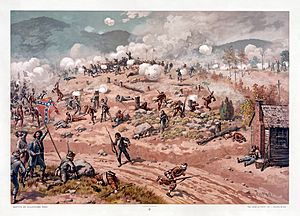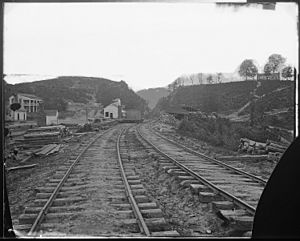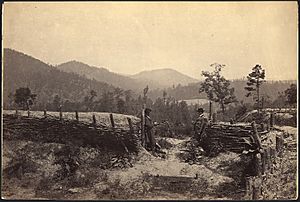Battle of Allatoona facts for kids
Quick facts for kids Battle of Allatoona |
|||||||
|---|---|---|---|---|---|---|---|
| Part of the American Civil War | |||||||
 Battle of Allatoona Pass, 1897 illustration |
|||||||
|
|||||||
| Belligerents | |||||||
| Commanders and leaders | |||||||
| John M. Corse (WIA) | Samuel G. French | ||||||
| Strength | |||||||
| 2,025 | 3,276 | ||||||
| Casualties and losses | |||||||
| 706 | 897 | ||||||
The Battle of Allatoona was an important fight during the American Civil War. It happened on October 5, 1864, in Bartow County, Georgia. This battle was the first big event of the Franklin–Nashville campaign.
Confederate soldiers, led by Major General Samuel G. French, attacked a Union army base. The Union soldiers, commanded by Brigadier General John M. Corse, were in a strong, protected spot. They were guarding the Western and Atlantic Railroad that ran through Allatoona Pass. The Confederate attack failed, and the Union forces won the battle.
Why Allatoona Was Important

After the city of Atlanta fell, Confederate General John Bell Hood moved his army north. His goal was to threaten the Western and Atlantic Railroad. This railroad was the main supply line for Union General William T. Sherman.
General Hood wanted to cut off Sherman's supplies. He ordered a part of his army, led by Major General Samuel G. French, to attack a key Union supply base. This base was located where the railroad went through a deep gap in the Allatoona Mountains. French's division included three brigades, led by Brigadier Generals Claudius Sears, Francis M. Cockrell, and William Hugh Young.
The Union base at Allatoona was defended by a small group of soldiers. They were led by Colonel John Eaton Tourtellotte. Before the Confederates arrived, General Sherman sent more soldiers from Rome to Allatoona. These reinforcements were led by Brigadier General John M. Corse, who then took command of all the Union troops there.
The Union soldiers had strong defenses. They were in two dirt forts, called redoubts, on each side of a deep railroad cut. Many of the Union soldiers, especially from the 7th Illinois, had special Henry repeating rifles. These rifles could fire many shots quickly.
The Battle Begins
General French's Confederate soldiers arrived at Allatoona Gap early on October 5. The battle started at 7:00 A.M. with a loud artillery bombardment. Confederate cannons fired at the Union forts for two hours. Union cannons fired back.
After the artillery stopped, General French sent a message to General Corse. He demanded that Corse surrender his troops. French said he had surrounded the Union forces and wanted to avoid more bloodshed. He gave Corse five minutes to decide.
General Corse quickly sent back his famous reply:
Your communication demanding surrender of my command I acknowledge receipt of, and respectfully reply that we are prepared for the "needless effusion of blood" whenever it is agreeable to you.
This meant Corse was ready to fight!
French then ordered his soldiers to attack. Sears's brigade attacked from the north, trying to get behind the forts. Cockrell's Missouri brigade, supported by Young's men, attacked from the west.
Corse's soldiers fought hard. They held their main fort, called the Star Fort, even under heavy attack. Union soldiers from the eastern fort were sent to help. The fighting was intense, and it looked like the Union forces might have to give up.
But around noon, General French got a report. His cavalry told him that a large Union force was coming from Acworth. Fearing his army would be trapped, French decided to pull back. He withdrew his troops at 2:00 P.M. More Union reinforcements arrived the next morning.
After the Battle
The Battle of Allatoona was small, but it was very bloody. Many soldiers were hurt or killed. The Union army had 706 casualties (soldiers killed, wounded, or captured). The Confederate army had 897 casualties.
General Ulysses S. Grant, who later became president, praised General Corse and his men for their brave stand. General Corse himself was wounded during the battle. The next day, he sent a message to General Sherman, joking, "I am short a cheek bone and one ear, but am able to whip all hell yet."
General French was not able to capture the railroad or the Union supply base. He especially regretted not being able to take or burn the one million rations (food supplies) stored there.
General Sherman's message to "hold the fort" at Allatoona became very famous. He sent it using signal flags. This message later inspired a popular religious song called Hold the Fort by Philip P. Bliss. The song's chorus was: 'Hold the fort, for I am coming'.



